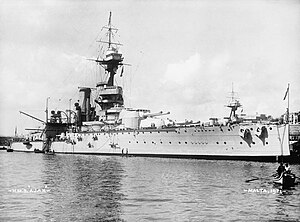
Back Аякс (линеен кораб, 1912) Bulgarian HMS Ajax (1912) German HMS Ajax (1912) Spanish اچاماس آژاکس (۱۹۱۲) Persian HMS Ajax (1912) Finnish אה"מ אייג'קס (1912) HE HMS Ajax (1912) Italian HMS Ajax (1912) Portuguese HMS Ajax (1912) Russian HMS Ajax (1912) Vietnamese

| |
| History | |
|---|---|
| Name | Ajax |
| Namesake | Ajax |
| Builder | Scotts Shipbuilding & Engineering, Greenock |
| Cost | £1,889,387 |
| Laid down | 27 February 1911 |
| Launched | 21 March 1912 |
| Completed | May 1913 |
| Commissioned | 31 October 1913 |
| Decommissioned | April 1924 |
| Out of service | October 1926 |
| Fate | Sold for scrap, 10 December 1926 |
| General characteristics (as built) | |
| Class and type | King George V-class dreadnought battleship |
| Displacement | 25,420 long tons (25,830 t) (normal) |
| Length | 597 ft 9 in (182.2 m) (o/a) |
| Beam | 89 ft 1 in (27.2 m) |
| Draught | 28 ft 8 in (8.7 m) |
| Installed power |
|
| Propulsion | 4 × shafts; 2 × steam turbine sets |
| Speed | 21 knots (39 km/h; 24 mph) |
| Range | 6,310 nmi (11,690 km; 7,260 mi) at 10 knots (19 km/h; 12 mph) |
| Complement | 869 (1914) |
| Armament |
|
| Armour | |
HMS Ajax was the third of four King George V-class dreadnought battleships built for the Royal Navy in the early 1910s. After commissioning in 1913, she spent the bulk of her career assigned to the Home and Grand Fleets. Aside from participating in the failed attempt to intercept the German ships that had bombarded Scarborough, Hartlepool and Whitby in late 1914, the Battle of Jutland in May 1916 and the inconclusive action of 19 August, her service during World War I generally consisted of routine patrols and training in the North Sea.
After the war, Ajax was assigned to the Mediterranean Fleet, where she took part in the Allied intervention in the Russian Civil War in the Black Sea in 1919–1920. The ship was deployed to Turkish waters during the Chanak Crisis of September–October 1922. Ajax was placed in reserve in 1924 before being sold for scrap two years later in accordance with the terms of the Washington Naval Treaty.